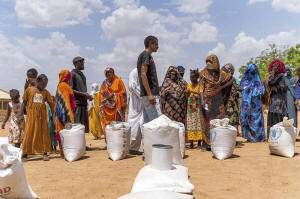World Bank warns that 39 fragile states are falling further behind as
conflicts grow, get deadlier
[June 28, 2025] By
PAUL WISEMAN
WASHINGTON (AP) — The world’s most desperate countries are falling
further and further behind, their plight worsened by conflicts that are
growing deadlier and more frequent.
That is the sobering conclusion of the World Bank’s first comprehensive
study of how 39 countries contending with “fragile and conflict-affected
situations’’ have fared since the COVID-19 pandemic struck in 2020.
“Economic stagnation —rather than growth —has been the norm in economies
hit by conflict and instability,” said Ayhan Kose, the World Bank’s
deputy chief economist.
Since 2020, the 39 countries, which range from the Marshall Islands in
the Pacific to Mozambique in sub-Saharan Africa, have seen their
economic output per person fall by an average 1.8% a year. In other
developing countries, by contrast, it grew by an average 2.9% a year
over the same period.
More than 420 million people in the fragile economies are living on less
than $3 a day — the bank’s definition of extreme poverty. That is more
than everywhere else combined, even though the 39 countries account for
less than 15% of the world’s people.
Many of these countries have longstanding problems with crumbling
infrastructure, weak governments and low levels of education. People in
the 39 countries get an average of just six years of schooling, three
years fewer than those in other low- and middle-income countries. Life
expectancy is five years shorter and infant mortality is twice as high.

Increasing conflicts have made things worse. In the 2000s, the world saw
an annual average of just over 6,000 conflicts — in which organized
groups used armed force against other groups or against civilians and
cause at least one death. Now the annual average exceeds 20,000. The
conflicts are more lethal, too: In the 2000s, they took an average of
fewer than 42,000 lives a year. From 2000 through 2024, the number
averaged almost 194,000.
[to top of second column] |

This June 2023 photo provided by the World Food Program shows food
distribution by the WFP for internally displaced persons at the Wad
Almajzoub farm camp in Wad Medani, Gezira state, Sudan. (Ala Kheir/U.N.
Office for the Coordination of Humanitarian Affairs via AP)

Of the 39 countries, 21 are involved in active conflicts, including
Ukraine, Sudan, Ethiopia and Gaza. The World Bank finds that countries
involved in high-intensity conflict — which kill more than 150 out of
every 1 million people — see a cumulative drop of 20% after five years
in their gross domestic product, the output of goods and services.
More conflict also means more hunger: The World Bank estimated that 18%
-- around 200 million – of the people in the 39 countries are
“experiencing acute food insecurity’’ compared with just 1% in other low
and middle-income countries.
Some countries have managed to escape the cycle of conflict and economic
fragility. Kose cites Nepal; Bosnia and Herzegovina; Rwanda; and Sri
Lanka as relative success stories.
And the World Bank report notes that the 39 countries do enjoy
strengths, including natural resources such as oil and natural gas and a
lot of young, working-age people at a time when many economies are
aging.
“Some of them are very rich when it comes to their tourism potential,’’
Kose said. “But you need to have security established. You and I are not
going to go and visit these places unless they are safe even though they
might be the most beautiful places in the world.’’
All contents © copyright 2025 Associated Press. All rights reserved |